St. Jude Family of Websites
Explore our cutting edge research, world-class patient care, career opportunities and more.
St. Jude Children's Research Hospital Home

- Fundraising
St. Jude Family of Websites
Explore our cutting edge research, world-class patient care, career opportunities and more.
St. Jude Children's Research Hospital Home

- Fundraising
Field-changing bird flu research has a long history — and bright future — at St. Jude

A St. Jude scientist discovered wild waterfowl as the natural reservoir of avian influenza virus, beginning 50 years of leading global flu research.
During the COVID-19 pandemic, another parallel pandemic emerged in birds worldwide: avian influenza, commonly known as bird flu. Poultry farmers, governments and international organizations are participating in a global campaign to control the virus. These efforts are informed by over 50 years of research from an unexpected place: St. Jude Children’s Research Hospital.
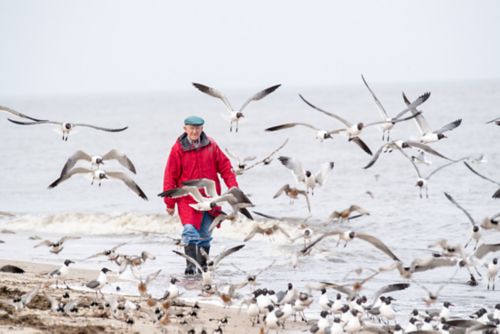
Robert Webster, PhD, St. Jude Department of Infectious Diseases emeritus member on the beach during an avian influenza sample collection trip.
Robert Webster, PhD, St. Jude Department of Infectious Diseases emeritus member, may be the single most influential avian influenza researcher in the world. His work identifying wild waterfowl as the natural reservoir for bird flu and the virus’s ability to directly infect humans set the stage for modern anti-avian flu infrastructure. This includes initiating and maintaining surveillance efforts while advancing understanding of the fundamentals of the virus.
He began this journey at St. Jude.
“People asked, ‘Why are you studying influenza at St. Jude?’” Webster said. “Immunosuppression, leading to infections such as influenza, mumps, measles and the common cold, was the real threat to our kids at the time.” When Webster joined, cure rates for pediatric cancers were improving drastically. One of the elements that improved upon those successful treatments was countering the infectious disease threats to patients, such as the flu, which were poorly understood. One of the first steps to doing so was finding where the flu comes from.
In 1975, St. Jude was designated a World Health Organization Collaborating Center for Influenza, quite an honor considering there were only six such centers in the world at that time. The center at St. Jude was unique in being designated the only center on the exchange of influenza viruses at the human-animal interface.
One of the first to find the flu in fowl
When Webster was a young scientist, influenza was something of a mystery. The annual flu season remained unexplained — it appeared every year, but no one understood where it came from. Webster, a New Zealander (or “Kiwi”) by birth, frequently went back and forth between the U.S. and Australia, where he earned his PhD. One day, happenstance led him onto the track that would define his career.
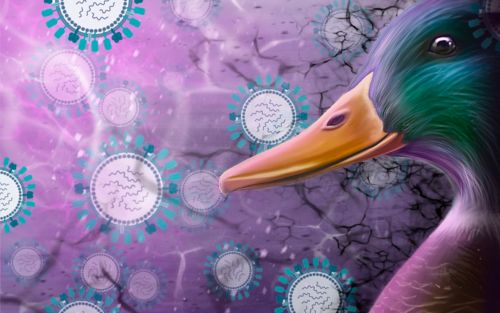
Webster and colleagues identified wild ducks are the main source of avian influenza virus. Artwork by Malcolm Houston.
“Graeme Laver and I walked on a beach north of Bateman’s Bay on the coast of New South Wales one morning and found it covered with dead mutton birds,” Webster remembered. “That year, South Africa had a big bird die-off of terns [seabirds related to gulls], and they’d isolated an influenza virus. We offhandedly suggested it may be flu in Australia too.”
While originally suggested as an absurdity, Webster and Laver did make a formal application to investigate the cause of death in these birds. While there was some initial hesitation to fund him (and some questions on scientific versus recreational motivations to visit the Great Barrier Reef), eventually, the World Health Organization (WHO) funded the work.
“The first year, we detected antibodies to that year’s circulating influenza virus in the mutton birds,” Webster said. “But we didn’t get any virus. So, we went back the next year and managed to isolate one or two influenza viruses.”
He then went himself to sample birds in Canada and the United States, finding wild ducks as the main source of the virus. With the ease of finding the virus and antibodies in large amounts, it begs the question: why had no one realized avian influenza was coming from these birds?
When a visiting Russian scientist found that the site of influenza virus replication in the duck was in the intestine, “It was one of those ‘eureka’ moments,” Webster explained.
“The virus was not in the respiratory tract — we’d been looking in the wrong end of the bird for years.”
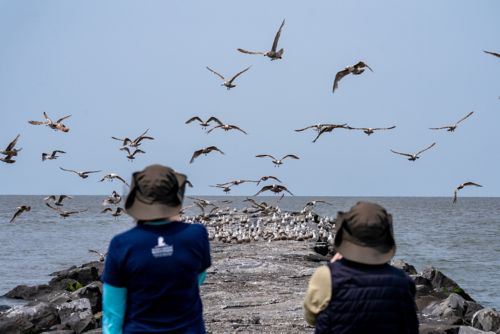
Two St. Jude scientists watch birds flying away during an annual collection trip.
In humans, influenza primarily infects the respiratory tract. Scientists had made the mistake of assuming that would be true for other species, but in birds, influenza infects the intestinal tract. Once the scientists started testing feces from the birds, they quickly found the virus.
Avian influenza infects first known humans
“We had quite a few quiet years after discovering where the virus was in ducks,” Webster said. “No serious outbreaks in humans or animals. The attitude was, ‘That’s not causing any problems, why bother about it?’”
At the time, the birds remained healthy even when teeming with the virus. No one observed any transfer to humans. Scientific funding institutions were becoming more reluctant to sponsor this research. However, the infrastructure for finding and identifying the virus would become necessary in 1996.
A child succumbed to an infection in Hong Kong, which was identified as influenza but did not correspond to a subtype known to infect humans. Few institutions had the resources to screen for other kinds of influenza, such as those in birds. After several failed identification attempts, researchers contacted the Webster lab, which had generated the appropriate materials (antibodies) to identify the virus in that quiet interim period.
The antibodies could identify the proteins that influenza uses to enter and exit cells. First, the hemagglutinin (H) protein, the viral protein that it uses to find and attach to the correct cells. Second, the neuraminidase (N) protein, which allows the virus to spread from infected cells. There are 18 H subtypes and 11 N subtypes, with different combinations associated with various infections. For example, H1N1 is believed to infect mammals primarily. Anything H5 was thought to exclusively infect birds until scientists in the Netherlands used Webster’s antibodies to identify the virus that killed the child in Hong Kong.
“When the test came back as H5, we thought initially that the folks in Hong Kong had contaminated the sample because we knew that they worked in the markets and it had never been seen before,” Webster said. “Eventually, we all accepted the fact that this child succumbed to H5N1.”
“When Dr. Webster went to Hong Kong,” explained Richard Webby, PhD, St. Jude Department of Host-Microbe Interactions. “It was the first time anyone realized people could be directly infected with these bird viruses. It changed the world of virology.”
“For many years, people always thought that a bird flu strain had to get into a pig and mix with another mammalian virus in order for it to gain the ability to infect people,” said Stacey Schultz-Cherry, PhD, St. Jude Department of Host-Microbe Interactions. “That appears to be true in most cases, but Dr. Webster’s work showed humans can get these viruses from birds directly.”
Six months after the first patient, Hong Kong experienced an outbreak of avian influenza that directly infected more humans, with a significant mortality rate. Webster was quickly able to find birds, including wild ducks, in the live poultry market that contained massive quantities of the virus, coordinating efforts to contain and manage the epidemic. He was invited for several years to help advise managing outbreaks after this, in addition to performing his research.
An excellent center for influenza research
“At about that stage, I decided, it’s time to get this stuff funded,” Webster said. “So, I wrote a grant to the National Institutes of Health (NIH) to really understand the flu. Why was it killing? What were the properties of these viruses? How did it develop into a killer strain?”
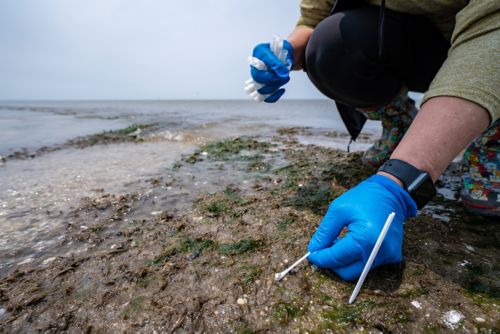
St. Jude scientists collect avian fecal samples from a beach where potentially infected birds congregate, which will later be processed to find and identify any influenza virus present.
Grant proposals to the NIH have never been easy. Many lab heads spend agonizingly long hours perfecting their grant applications, only to be disappointed with the decision. Webster’s experience was different.
“I asked for a fairly modest amount of money,” Webster reminisced. “NIH came back and said, ‘No, what we want to do now is to give you even more money than you requested. Instead of three years, we’re going to give you five years.’
“That first grant was so tremendously successful that when the five years were up, NIH created the Center of Excellence with six centers for flu in the United States,” Webster said. “It grew out of St. Jude — we were responsible for these programs starting, and they’re still ongoing today.”
St. Jude received its first distinguishment as one of these programs in 2007 from the National Institute for Allergy and Infectious Diseases (NIAID), a part of the NIH. Each Center of Excellence for Influenza Research and Response (CEIRR) is tasked with developing tools to control epidemic or pandemic influenza while finding ways to minimize the threat of an influenza pandemic, including those emerging from animal viruses. CEIRR’s ongoing work on human influenza shows promise for protecting and preventing infection. Since 1975, St. Jude has also been designated one of seven World Health Organization (WHO) Collaborating Centers with the WHO Global Influenza Surveillance and Response System (GISRS) to participate in global surveillance and control of the virus, including animal sources of outbreaks.
Webby and Schultz-Cherry serve as co-directors of CEIRR. They are quick to give credit to the mentor who preceded them and whose work laid the foundations for their own careers.
“We’re following in the footprints and the traditions of Robert Webster,” Shultz-Cherry said. “We continue that legacy of infectious disease research.”
“Dr. Webster’s projects are probably the longest-running flu surveillance programs in the world,” said Webby, who now oversees several of those projects. “We have partners around the world that we work with to collect samples in decades-long collaborations he established.”
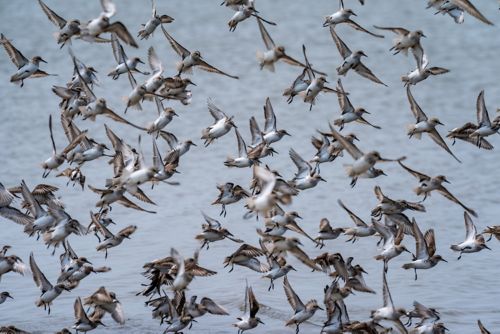
Ruddy turnstones (Arenaria interpres) a bird species known to harbor influenza.
“Dr. Webster spent his career learning avian influenza ecology and researching flu pandemic potential,” said Charles Russell, PhD, St. Jude Department of Host-Microbe Interactions. “That field of research all goes back to him.”
The ongoing legacy of St. Jude influenza research
Webster is proud of what his protégés have done to move the influenza field forward.
“They’re doing damn good work,” Webster emphatically stated. “When I read their papers, I’m impressed with what they’re doing, and they are doing things that we could never have imagined.”
Multiple investigators at St. Jude, including Webby and Schultz-Cherry, continue advancing cutting-edge bird flu research. One such investigator is Russell, who also trained for a time under Webster.
“Rob Webster was instrumental in getting me involved in the field,” Russell remembered. “I had a background in protein structure and function, and we collaborated on understanding influenza hemagglutinin (H) protein, funded by the original version of CEIRR.”
Russell specializes in understanding how the stability of the H protein affects transmission and infection. One of his more recent studies found that the more stable the protein was, the more likely it could be transmitted between ferrets. This is because the upper respiratory tract of humans is mildly acidic, so more molecularly stable H proteins better resist premature activation from the acid.
WHO and Centers for Disease Control (CDC) watch for mutations that make a virus more likely to jump from avian hosts to humans. Russell’s work indicates that adding H stability to that screening may improve pandemic potential risk predictions. This ties directly into what he learned from Webster.
“Dr. Webster was the original flu surveillance guy,” Russell said. “His work led to the understanding that while we have the seasonal flu that spreads, there is an enormous amount of diversity. We also have these unknown flu viruses spreading in wild aquatic birds, which we need to understand better.”
Tracking the avian flu today
To learn more about flu’s spread in birds, Webby has continued much avian flu surveillance work and its downstream virological research. For example, every year, Webby lab members travel to Delaware Bay to collect bird flu samples.
“Pulling viruses out from Delaware Bay for so long has given us insight into the transmission of viruses and what’s important, such as what type of host response can actually drive transmission,” Webby said.
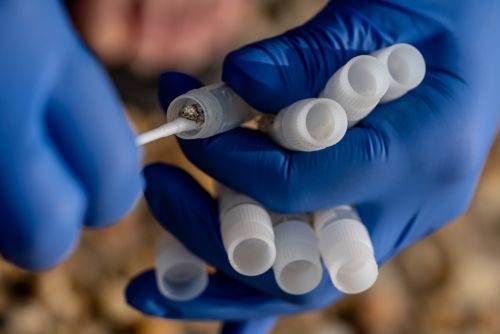
For decades, St. Jude virologists and their collaborators have collected thousands of samples annually to study and surveil avian influenza, to better understand the virus and protect against its crossover into humans.
In addition to Delaware Bay, St. Jude works with international groups to collect samples around the globe. They’ve identified the ancestors of the current H5N1 strain killing birds in the Americas — and why it is spreading so fast.
“The pandemic H5N1 is better adapted to wild birds than any other highly pathogenic viruses we’ve ever seen,” Webby explained. “That’s best reflected by the fact that prior to this outbreak, we had one spillover event from another hemisphere that led to short-lived epidemics. For this virus, we have tracked at least six spillovers, from a combination of Western Europe and East Asia to the West Coast [of North America].”
The transmissibility appears to be helped by access to a different form of neuraminidase (N), which allows the virus to exit from cells to spread. At some time in North America, the virus mixed with existing flu viruses in wild birds to also produce a more virulent strain.
“This virus is doing something these avian flu [strains] haven’t done in the past,” Webby said. “The virus is really neurotropic, both in the birds but also in also in the wild mammals. When we used our experimental ferret model, we found huge viral loads in the brain.”
Influenza hosts influence risk
While Webby looks into how the virus spreads in birds, Schultz-Cherry looks at mammalian hosts’ risks for and during influenza infection.
“Most of my work is in South America, where I have several studies looking at influenza in humans,” Schultz-Cherry said. “We monitor birds, pigs and now marine mammals and pets in Chile, as well as the people in contact with them.”
“We also see health disparities by studying these populations,” Schultz-Cherry said. “For example, the highly pathogenic H5N1 Dr. Webby is studying continues to spread westward and is really becoming an ecological disaster, particularly in South America.”
People around the world may lack adequate access to refrigeration, which directly impacts influenza, according to Schultz-Cherry’s work. They must live in close proximity to pigs and chickens to have fresh meat available, which increases the risk of animal-to-human transition (zoonotic disease). In addition, these people are much less likely to be vaccinated.
Schultz-Cherry, therefore, studies rural and indigenous people of Colombia, as well as people in close contact with animals, a more representative population of the majority of the world that lives outside of fully industrialized nations, to understand how to combat the flu better.
“What we’re finding,” said Schultz-Cherry, “is that we’re going to need to take a different approach to making a vaccine that is good at protecting these high-risk populations than what we’ve conventionally implemented.”
Her lab is currently observing influenza and immunology within these communities to find the best path forward for interventions, using knowledge generated by other St. Jude scientists, such as Russell’s insight into the H protein and Webby’s work identifying the potentially dangerous features of avian flu.
“We’re all moving Dr. Webster’s research legacy forward in very different ways, which highlights the strength of the influenza program at St. Jude,” Schultz-Cherry concluded.
Keeping up with the fight against the flu
Webster may be partially retired, but he keeps abreast of current avian influenza threats. The ongoing H5N1 pandemic in domestic poultry and wild birds concerns him, especially after seeing the impact of the SARS-CoV-2 pandemic.
“COVID was bad enough,” Webster explained. “SARS-CoV-2 serves a very important purpose to show what a pandemic virus can do to the world’s economy. Right now, in South America, H5N1 is killing wild birds, seals and bears. That pathogenicity means it has the potential of being a big danger.”
Webster may be one of the best people in the world to know what represents a global pandemic threat. He went to and from countries across the globe, including Russia, China and, in one case, Antarctica, throughout his career, consulting on the flu and virus outbreaks. In that time, he made St. Jude a well-known name for high-quality influenza research throughout the scientific community.
“I have to admit that I’ve been very spoiled by St. Jude,” Webster said. “The facilities here are top-class, letting us lead the international influenza research community. That’s only possible through the full support of WHO, NIAID and St. Jude donors. I hope that support continues so my trainees can continue the fight against the flu.”
Even as the SARS-CoV-2 pandemic comes under control, the current H5N1 outbreak in birds shows that the influenza virus still looms large as a public health threat. St. Jude researchers, armed with continued support, will carry on the work of Webster, staying at the forefront of understanding and opposing avian influenza and its potential crossover to humans.
St. Jude continues to be a Collaborating Center for WHO under the co-direction of Stacey Schultz-Cherry and Richard Webby.






